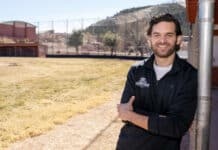For many years, there was a bit of a riff between Yavapai College and Sedona residents who didn’t feel as though they were getting enough bang out of the their tax buck.
But in recent years, the college has made strides to offer more courses at the Sedona campus and will continue to do so, said Verde Valley Campus Dean James Perey, who spoke to the Sedona City Council on Tuesday, Nov. 28.
Perey covered a variety of topics including tuition, enrollment and the balance between offering classes for those who are seeking to obtain a degree and those who are simply looking to take a class here and there.
Perey said the college is very diverse in terms of age of its students. Some research has shown that Yavapai County may be a pilot program for what’s going to happen throughout the country as the population lives longer, he said.
But a concern they have is that 60 percent of incoming students — whether straight from high school or returning students — require some sort of remediation. He said it applies to the entire Yavapai College system with most of the shortfalls coming in math and English.
“My philosophy is to have a seamless transition between high school and secondary education with the intent that if those students want to go to work, they’re prepared to do so and if they want to transfer to another university or college, they have the ability to do that as well,” he said.
He said one of the college’s priorities is to continue offering courses that tie into local businesses such as culinary, hospitality and viticulture. But now it’s time they start focusing on smaller sectors and how they can help business owners to expand or increase the education of their workforce.
Programs that are in the works include revamping hotel and restaurant management in order to meet workforce needs but also to enable credits to be transferred to Northern Arizona University.
Perey said that a problem they’re facing is that the enrollment within the hotel and restaurant management program is very low but added that he hasn’t given up hope.
“Those numbers are getting better but still not great,” he said. “We’ve got about two months before we have to make a hard call when classes start for the next semester but I’m optimistic that we can get the enrollment.”
Yavapai College has embarked upon a pathways project, which is designed to align its curriculum with the needs of the students. This is because many students often take courses they don’t need.
He said it’s not uncommon for a student to receive their associate degree and have 75 credits when only 60 are required.
“We want to make sure students are only taking what they need,” he said. “We want to make sure students don’t self-advise and that they’re meeting with an academic adviser to make sure they know what they need to take. We want everyone to have a plan regardless if they are there full time or part time.”
He said they’re also looking at the number of courses that are offered and which ones are needed.
“Too many options can actually paralyze a student when making a decision,” he said. “We want them to make educated decisions.”
Perey said a trend most community colleges across the country see, including theirs, is that when unemployment is low — as it is now — enrollment drops as well.
“When unemployment goes up, people come back to school and retool for a career and they go into something different,” he said. “When the economy is more stable, they tend to stay put.”
And with enrollment down, he said one of their goals goes back to aligning themselves with local industries to entice students to stay local and find jobs within the region.
On the other end of the spectrum is the college’s nursing program, offered in Prescott and Clarkdale. It’s so successful that there are not enough openings each year within the county to hire those graduates so they must seek employment elsewhere. Other points Perey addressed included:
- Yavapai College captures between 25 to 30 percent of graduating seniors in the county.
- Cost of living in Yavapai County is higher than the national and state average. This can often impact enrollment.
- Some of the biggest employers throughout the county include local government, full-service restaurants, elementary and secondary education and health care. So, they are trying to offer more courses geared toward those careers.
- Only 26 percent of incoming students meet all the college benchmarks, which has become a significant issue. Instead of playing the blame game, he said they are looking at how to remedy this problem.
- The college has flexibility in terms of hiring teachers who are highly trained in a trade skill but may not have teaching credentials.
- There will be a greater emphasis on classes offered in trade skills. Councilman John Currivan addressed what Perey said in terms of the hotel and restaurant management courses and asked whether or not they are in jeopardy of being canceled despite enrollment being slightly higher.
- “I have the flexibility to make some tough decisions in regard to new curriculum, especially when it comes to something we know is needed,” Perey said. “Hypothetically, when I look at a program, ideally I’d have 15 to 20 students in a class in order to launch it. With this particular curriculum, I’ve got some flexibility to adjust those numbers to get it off the ground. I think once we get some students in there and see the positive outcomes of that program, it will continue to grow. But I’m willing to make some sacrifices in order to get it off the ground.”
Ron Eland can be reached at 282-7795, ext. 122 or by email at reland@larsonnewspapers.com

















